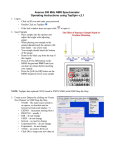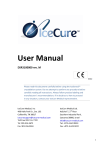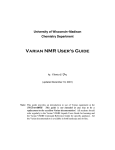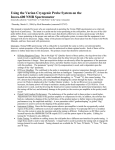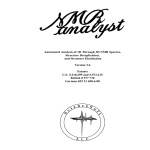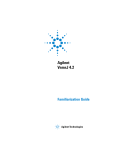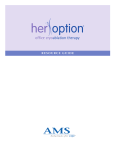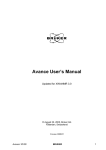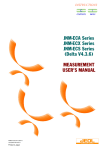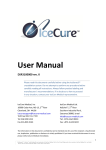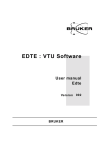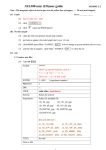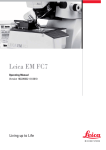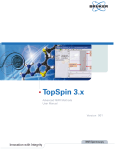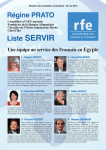Download Users` Guide for TXI CryoProbe
Transcript
DEPARTMENT OF CHEMISTRY AND BIOCHEMISTRY University of Delaware TXICryoProbeUser’s Guide NMR LAB APPLICATIONS NOTES CryoProbe User’s Guide Revised March 2010 University of Delaware Newark, Delaware 19716 C R Y O P R O B E 1 G U I D E Warnings and limitations T he CryoProbe contains a tuned NMR coil assembly, a gradient coil, preamplifier electronics, and supervisor electronics inside a vacuumed isolated dewar. Cold helium gas is circulated to cool the NMR coil assembly and preamplifier electronics while the sample is kept at ambient temperature. All the common probe functions needed for RF transmission, tuning, gradient pulses, and VT gas duct are built into the CryoPorbe, while the sample lift and spinning are provided as usual the shim upper part. The thermal noise is greatly reduced by cooling the NMR coil assembly and the preamplifier to cryogenic temperatures. Furthermore, the low electrical resistance enhanced the Q factor of all resonant circuits in the probe and its filters. Cautions • When an automatic warm-up or building power failure happen during your experiment, stop data acquisition and eject your sample immediately • User must constantly check the status of CryoProbe when a long experiment is on the way to make sure it is in a normal operation condition • NEVER set TD greater than 2K for a 2D 1H-15N HSQC experiment • NEVER set proton power level (value) less than 3.5 dB • IF the wobble curve is far away from optimum position, stop tuning and contact NMR staff. • DO NOT tune the probe when it is warm • DO NOT apply ant RF power to the probe when it is warm • NEVER turn off VT gas when CryoProbe RF-coils are below room temperatures 1 C R Y O P R O B E G U I D E Sample: Geometric limitations • MAXIMUM sample diameter: 5.00 cm • MAXIMUM sample depth: 19.0 cm • MINIMUM sample depth: 16.0 cm for regular tube and 15.0 cm for Shigemi tube Sample Temperature Regulation Limitations • MINIMUM gas flow rate: 600 l/h • MAXIMUM VT heating power (BVT3000): 15% @ 670 l/h • Sample temperature range: 10 – 60 °C 2 C R Y O P R O B E 2 G U I D E CryoPanel Operation C ryoPanel is a graphical user interface (GUI) for controlling and monitoring a Bruker CryoProbe system. CryoPanel is completely integrated into TopSpin software. To start CryoPanel, type cryopanel in the command line of TopSpin. Alternatively, click on the user-defined button labeled as CP on the top of the data set to start the CryoPanel. CryoProbe Status Once CryoPanel started, click on the icon (one with two squared boxes in the upper left corner of each tab windows) to detach CryoPanel from TopSpin. If TopsSpin is closed then CryoPanel will also be closed. In Main display of the CryoPanel, there are two Tabs are most useful: Main and Graph. In Main Tab, all operational information of CryoProbe since last cool-down are provided. The Warmup and Cooldown buttons are for warm up and cool down the probe, should only be used by the system administrators. Other parameters in the Main Tab are described below: • NMRDev(K): when probe is cold and running normally, this parameter should always be very close to 0.00. • NMRCoil Heater: it depends on the firmware of software, this parameter ranges from 5 to 25. It may decrease a little bit during an experiment with a strong decoupling. Watch this parameter during experiment setup, and make sure this parameter reach to a stable value when steady state of the experiment is established. • PreampDev(K): when probe is cold and running normally, this parameter should also be very close to 0.00. If this parameter reaches to 10 to 15, stop the experiment immediately and lower decoupling powers before trying it again. C R Y O P R O B E G U I D E • Preamp Heater: it depends on the firmware of software, this parameter ranges from 50 to 95. It may fluctuate a little bit during a strong decoupling experiment. When the value of this parameter is dropped to below 50, the probe usually needs a warm-up/cool-down cycle. It is not appropriate to start a long experiment at this point. In Graph Tab, most of the parameters discussed above can be displayed graphically. 4 C R Y O P R O B E 3 G U I D E RF Power Limitations T he efficiency of CryoProbe requires less RF power for a given RF field strength than a conventional probe. The maximum RF power from AVANCE system would destroy the CryoProbe. This is true for both hard pulses and shaped pulses. Bruker software has some sort of internal constrains for setting up the power levels, but it only works for proton channel. Extra care must be taken in setting up the power levels. In case of high RF power inputs, the CryoProbe will overheated, and which leads to malfunctioning of probe. In a worst case, the CryoProbe will automatically warm up and may destroy the probe itself. The power limitations are applied to the hard pulses, shaped pulses, as well as decoupling powers. RF Pulses • MAXIMUM power levels (PL1-PL3) are listed in Table 3.1. The pulse widths according to these power levels are calibrated based on an organic solvent. • For a H2O/D2O solvent, pulse widths, especially for proton, are expected to be longer. The power levels must be set not greater than those listed in the table even for a long pulse width. Numerically, PL values must be set higher than the numbers in the Table. • When hard pulsewidths changed with the solvent or sample, one can use edprosol or pulse command to calculate the power levels corresponding to longer 90 pulses. For example, if the 90 pulse for proton is calibrated as 12 usec. @ PL1 of 3.5, the TOCSY spin-lock pulse (30 usec) can be calculated by typing pulse 30us in the TopSpin command line. The edprosol provides a graphical user interface for these calculations. • Always make sure the optimum tuning and matching because the unmatched case is even more demanding for the RF electronics. Often, the greater changes in probe tuning are found with proton channel. C R Y O P R O B E G U I D E Table 2.1 Maximum RF Power Levels C-13 90 ° Pulse (micro seconds) 15.3 Power settings(dB) -2.3 (PL2) 25.5 2.14 65 10.26 45 -1.3 (PL3) 200 11.6 H-1 8.3 3.5 (PL1) H-2 275 -4.1dB N-15 Simultaneous Hard Pulses • When two RF pulse are applied to an NMR coil at the same time, the power of two pulses must be reduced by 6dB each. In case of three simultaneous pulses, the reduction is 10dB. Decoupling Power • The decoupling power required by a CryoProbe for a given RF field strength is much smaller than in a conventional probe. In case where the average RF exceeds the cooling capacity of the system, the NMR coil cannot keep its normal operating temperature. As the temperature warms up to 5K higher than normal temperature, the COLD button starts flashing. If this occurs, reduce the average RF power until the light is steady green again. If most of the average RF power is due to decoupling during the acquisition, consider a shorter acquisition time. The ERROR light flashes when the coil temperature is greater than 15K of normal operating temperature, in case this happens, stop the experiment immediately! When the coil temperature is 20K higher than the normal operating temperature, an automatically warm-up will start. Stop all RF 6 C R Y O P R O B E G U I D E pulsing, and reduce the RF power. Wait until the RF coils cools down before restarting the experiment. • The actual temperatures of RF coils can also be read from the CryoPanel GUI. Shaped Pulse Power Once hard pulses are calibrated, the power for the shaped pulse can be estimated using the Shaped Pulse Tool. 7 C R Y O P R O B E 4 G U I D E Parameters I n this section, the general instructions to set experimental parameters will be given. Special cautions on solvent suppression and H2O solvent sample will also discussed. General • When running a long experiment with extensive decoupling or spin-lock, check the progress of the acquisition during the first few minutes after it is started. In case of excessive heating the NMR coil assembly with RF, the system will send error message and might automatically halt the experiments or even warm-up the CryoProbe. Receiver Setting • The effective digitizer resolution dr should be 18 bit or larger to keep quantification noise at a negligible level. Use a small sweep width swh for your particular experiment. • Do not use rga to set receiver gain because rga intends to use only 50% of the available ADC range. In the gs mode, adjust rg such that at least 100,000 unit on the y-axis in the FID display window acqu is filled with FID signals. Shimming • Topshim: the standard shim-files are constantly updated by the NMR staff. To retrieve most updated shim file, type rsh in command line, a list C R Y O P R O B E G U I D E of current shim files is shown. Select one that is most recently updated with a correct solvent. Lock the spectrometer frequency with appropriate solvent. To shim the sample with H2O/D2O solvent, use command topshim 3d. After a 3D shimming, one can do a 1D shimming by typing topshim. For non-aqueous solvents, use only 1D shimming by typing topshim in TopSpin command line, followed by a quick adjustments of shim gradients x and y, respectively.. • H2O solvent sample: A temperature gradient inside the sample solution can spoil the resolution even if the shim and the water suppression are excellent. The most prominent temperature gradient is linear along the zaxis. Since the position of the water resonance is temperature dependent, a linear resonance shift along the z-axis would result. When shimming with D2O using the lock level, one would balance the temperature shift of the water resonance with the z-shim because this would superimpose the water signals from the different regions of the sample and thus increase the lock level. But a misset z-shim affects all resonance and spoils their lineshapes. In case of an apparently ‘optimum’ shim unit but unsatisfactory resolution, start an acquisition in the gs mode with one-line Fourier transform and touch up Z, X, Y, ZX, ZY. Other shims are usually of little effect. Solvent Suppression • Due to the inherent restrictions in a CryoProbe, the RF coil must be located further away from the sample as compared to conventional probes. As a consequence, RF fringe fields extend further above and below the main samples region, which makes the solvent suppression more difficult. • It is said all standard method like PRESATURATION, WATERGATE, and EXCITATION SCULPTING can be used as usual. We found a modified WATERGATE sequence (w5) works better. The pulse program is zggpw5. Select a method that allows rg>100 for which the receiver noise is negligible. Gradients • Gradient experiment may be benefit from increasing the gradient strength relative to conventional probe by 10 – 20 unit on the % scale. Sinc shapes with 100 steps resolution are used as usual. 9 B R U K E R D O C U M E N T S 5 Probe Tuning, Shim and Acquisition Files Probe Tuning • The CryoProbe has a tuning adaptor at the bottom of the probe, just like the conventional probe. For each pair, the long actuator is for tuning and short one is for matching. Use the blue tuning tool to operate the actuators. The Bruker color code applies to the color of actuators: Yellow: White: Blue: Red: 1H 2H 13C 15N • Do not force the actuators beyond easily recognizable limits. Do not challenge the limits of the tuning and matching range. Do not use non-Bruker tools for tuning and matching. • Often, only 1H tuning setting changes with the change of solvent and temperatures. NOTE: if the wobble curve is far away from optimum position, DO NOT tune the probe at this point, contact NMT staff instead! Shim Files • A sample (2mM sucrose in 90% H2O and 10% D2O + 0.5MM DSS) is used asa standard to update shim file from time to time. The standard shim file of the UD NMR facility has the format as CRYO_H2O_nnnnnn, where nnnnnn is a six digits numerical number represents the date that the file is generated. For example, the file CRYO_H2O_071809 indicates this shim file is generated for the CryoProbe using water solvent and the file is created on July 18, 2009. • Due to strong dependent of shim values on the sample and sample tube, it is recommended to save your own shim file whenever a good magnetic homogeneity is reached. Please use your own file format to avoid any confusion with the facility format. 10 B R U K E R D O C U M E N T S Acquisition Files and Acquisitions • Several acquisition files (Table 5.1) for the common NMR experiments have been saved for your convenience. Like the shim files, acquisition file format for CryoProbe are saved in a format of cryo_expmethodspecial. For example, the file cryo_mlevwggp indicates the acquisition file is for the CryoProbe (cryo_), the experiment is a TOCSY with mlev sequence for spin-lock, the pulse program contains a WATERGATE sequence (wg) and running with a gradient pulses (gp). • All these files, created for your convenience, have been completely tested and proved to be safe with the CryoProbe. However, it is not our intention to replace standard procedures of setting up a successful experiment. To use these acquisition files, one must always calibrate the proton 90° pulse for your sample in at PL1 level at 3.5 dB. In other words, the numerical number for PL1 level must be equal to 3.5dB. Then update corresponding parameters use ased and gpro commands. The details of the experiment method and references can be found by typing edcpul at the current experiment. • Use rpar command to load the related acquisition file. Change any acquisition parameters such as pulsewidth (us), rf power level (PLs), sw, sw1, ns etc. when needed. Most often, only 1H pulse width needs to be changed. • Run gs to set appropriate receiver gain (rg). Also, watch lock level, coil temperature indication line (blue) and coil heating reserve (green) on CryoTool (laptop computer) closely to make sure no dramatic changes occur. • Often, you will note a drop in lock level when hsqc type of experiment is running. Change z1 to recovery the lock level. Then type stop to terminate gs command. Again a drop in lock level will be observed when gs mode is terminated. Start experiment with large ds (32) to create steady state and to allow the recovery of the lock level. Watch the experiment for a few minute to make sure everything is OK before let experiment continue. Table 5.1 Acquisition Parameter Files Experiment Water suppression Water suppression TOCSY File Name Comments cryo_wsse Water suppression using excitation sculpting cryo_wsgpw5 Watergate w5 sequence cryo_mlevwggp TOCSY (mlev) with watergate 11 B R U K E R D O C U M E N T S TOCSY cryo_dipsiesgpph TOCSY(DIPSI) with water suppression NOESY cryo_noesygpph19 NOESY with watergate ROESY cryo_roesyesgpph ROESY with excitation sculpting 13C-HSQC cryo_hsqcetgpsisp 13C-HSQC (shaped pulse for all 180 pulse in f2) 13C-HSQC cryo_hsqcetgpsi 15N-HSQC cryo_n15hsqcf3gpphwg 15N-HSQC Watergate using f3 channel for N-15 12 B R U K E R D O C U M E N T S 6 Bruker Documents CryoProbe System User Manual • This document describes the safety, Probe Installations, Operations of CryoPlatform Unit, Warm-up and cool-down procedures, Monitoring and Maintenance, as well as Troubleshooting. This document is mainly written for a system manager with a maintenance responsibility. The document can be found in the cabinet behind the spectrometer. Typical Pulse for 5mm CryoPorbe (500/600 MHz) • This document is attached to the User’s Guide for your references. It is strongly recommended to read this document before running experiment on a CryoProbe. Exchange He Steel Cylinder • This document provides instruction of switching He Steel Cylinder for He compressor. This document is mainly written for a system manager with a maintenance responsibility 13















